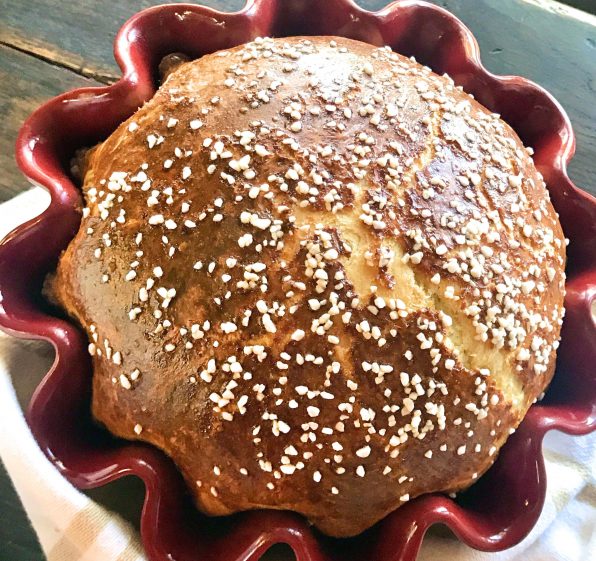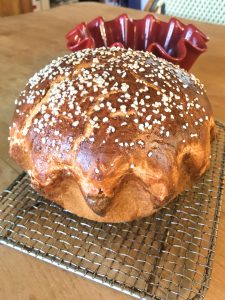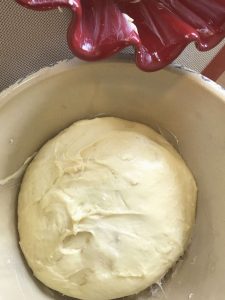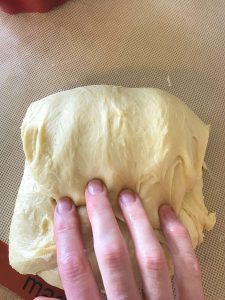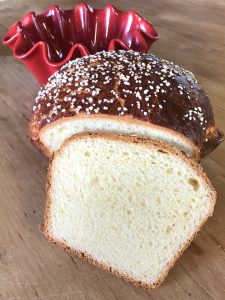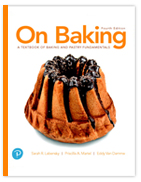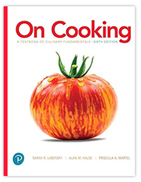As close to cake as any yeast bread, brioche relies on butter, eggs and an overnight fermentation to develop its delectable flavor. This One Step Brioche recipe does not skimp on the butter, but it is made more quickly that its French cousin.
Rich dough like this one for brioche requires a thorough kneading. For this reason, I always mix such doughs in a stand mixer or food processor. In this recipe, I use my stand mixer fitted with a spiral dough hook because it is up to the task.
As with most brioche recipes, I add the butter in two stages – some with the flour and the rest kneaded in once the dough is formed. Because fat interferes with the development of the gluten bond, you need to add the butter this way. I think it gives the dough a tender and almost flaky texture.
You do need softened butter to do this. Softened butter is pliable but not melting. To quickly soften butter, cut it into tablespoon-sized pieces and let it sit out for about 10 minutes. Test a piece by squeezing it between your thumb and forefinger. If it is easily compressed, the butter is ready to be used. (Save this tip for any recipe that calls for softened butter.)
Rich dough requires warm temperatures in which to rise but not so hot as to melt the butter. For this reason, the time required for the One Step Brioche dough to ferment (rise) and proof (rise again in the pan) varies a good deal. In a cozy kitchen at 70 -72°F, your bread may rise in as little as 2 hours. If your kitchen is cool, expect the dough to take longer to ferment and proof.
Here is the brioche dough close to fully fermented.
When the dough has fermented, scrape it out onto a silicone baking mat or very lightly floured work surface. To round it into a ball, lift up one edge and fold it over to the other side as shown here. Turn the dough and repeat these three or four times until you have a round ball shape.
What to do with this bread? Eat it with butter or jam. Ham or prosciutto sandwiches. Finger sandwiches made with sliced cucumber and watercress if you are feeling fancy. Smoked salmon or other fish. I’ve even used it as a base for an ice cream cake.
KITCHEN NOTEBOOK
This recipe derives from the rich sandwich bread girls at Abbot Academy ate for many years, when Jess Bonde ran the kitchens. Classmates asked me if I could reproduce it. And someone shared the original recipe, which makes 20 loaves. I’ve tweaked it a couple of times and think this version worthy of making in a fluted brioche mold. (If you are looking for a classic brioche, I’ll post a classic brioche recipe, one with the characteristic top knot and overnight fermentation.)
Emile Henry provided me with its bright red ceramic brioche mold to test. I love their products. I have worked with for them in the past and was happy to test this mold in this recipe.
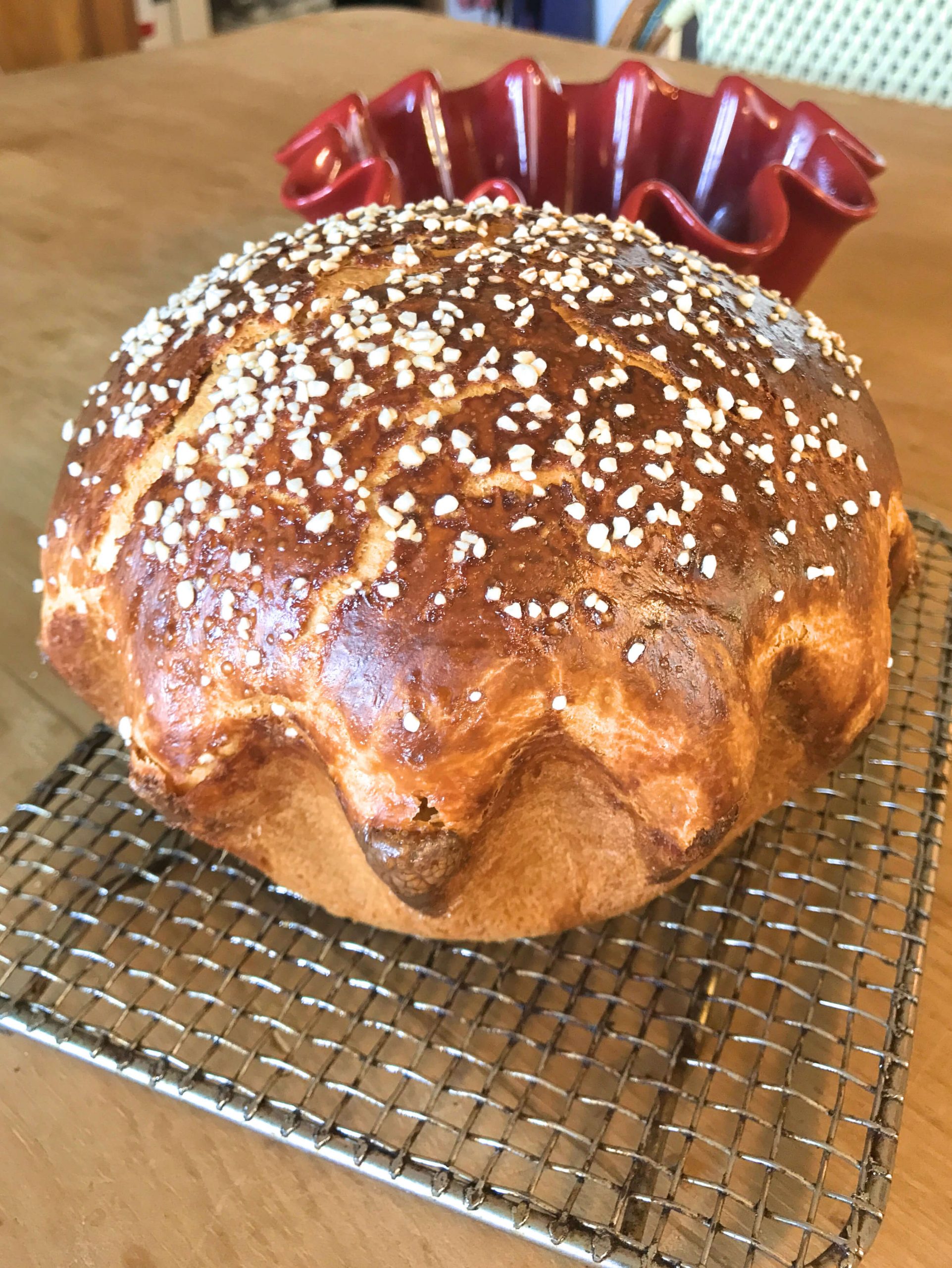
As close to cake as any yeast bread, brioche relies on butter, eggs and an overnight fermentation to develop its delectable flavor. This One Step Brioche recipe does not skimp on the butter, but it is made more quickly that its French cousin.
Ingredients
2 teaspoons instant yeast
3 tablespoons water 90°F
1/4 cup granulated sugar
7 ounces unsalted butter, softened
1 teaspoon kosher salt
1/4 cup dry milk powder
2 eggs, lightly beaten
4 fluid ounces (1/2 cup) warm water
13 ounces (2 ¾ - 3 ¼ cups) bread flour
Egg wash: 1 egg beaten with 1 tablespoon water
Pearl or coarse sugar, for garnish
Directions
- Stir together the yeast and the 3 tablespoons of 90°F water. Set aside.
- Place the sugar, 3 ounces of the butter, the salt, milk powder and eggs in the bowl of a mixer fitted with the dough hook. Add the remaining 4 fluid ounces warm water and half of the flour. Mix to combine the ingredients.
- Add the yeast mixture and remaining flour. Mix the dough on medium speed for just a few minutes until all the flour is moistened. Scrape down the sides of the bowl.
- Knead the dough on medium speed, scraping the sides of the bowl from time to time, until the dough is smooth and elastic, for approximately 7-8 minutes.
- Add the remaining 4 ounces of butter, a little at a time, kneading on medium speed until it is incorporated.
- Gather the dough into a ball. Place it in a deep container or bowl. Cover and let the dough ferment (rise) until doubled in volume for approximately 2 – 3 hours.
- Preheat the oven to 350°F. Place a small pan on the bottom of the oven. (This will be used to create steam in the oven.) Grease a 10-inch brioche or other mold.
- Scrape the dough onto a lightly floured work surface. Shape the dough into one large round loaf. Gently press the dough into an even circle. To round it into a ball, lift up one edge and fold it over to the other side. Turn the dough and repeat these three or four times until you have a round ball shape. Place it in the prepared pan.
- Brush the dough with the egg wash. Cover and allow the dough to proof until nearly doubled in volume, for approximately 1 ½ - 3 hours depending on the room temperature.
- Sprinkle the surface of the proofed dough with pearl sugar. Place the bread in the oven. Carefully pour about 1 cup of hot water into the pan on the bottom of the oven. Close the door and bake for 40-45 minutes until the dough is golden brown and makes a hollow sound when tapped on the bottom.
- Remove the loaf from the mold and cool it on a rack.
Notes
Pearl sugar, which I used in this recipe, is compressed so that the sugar will not melt after baking. You can find it at Ikea and at many online stores.The brand I used is called Lars Own Belgian Pearl Sugar.

